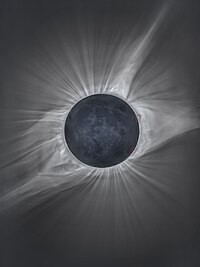
Photo from wikipedia
We conducted an experiment in conjunction with the total solar eclipse of 1 August 2008 in China to determine the thermal electron temperature in the low solar corona close to… Click to show full abstract
We conducted an experiment in conjunction with the total solar eclipse of 1 August 2008 in China to determine the thermal electron temperature in the low solar corona close to the solar limb. The instrument, Imaging Spectrograph of Coronal Electrons (ISCORE), consisted of an eight-inch f/10 Schmidt Cassegrain telescope with a thermoelectrically-cooled CCD camera at the focal plane. Results are electron temperatures of 1 MK at 1.08R⊙ and 1.13R⊙ from the Sun center in the polar and equatorial regions, respectively. This experiment confirms the results of an earlier experiment conducted in conjunction with the total eclipse of 29 March 2006 in Libya, and results are that at a given coronal height the electron temperature in the polar region is larger than at the equatorial region. In this paper we show the importance of using the correct photospheric spectrum pertinent to the solar activity phase at the time of the experiment, which is a required parameter for modeling the underlying theoretical concept for temperature interpretation of the measured intensity ratios using color filters.
Journal Title: Journal of Geophysical Research
Year Published: 2017
Link to full text (if available)
Share on Social Media: Sign Up to like & get
recommendations!